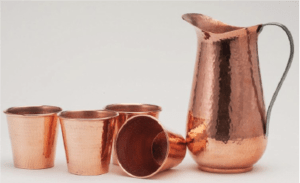
Advanced P4 Metal Technology has emerged in response to the urgent need to address water contamination and the spread of infections. By bonding polymers with copper or silver in nano form, this technology harnesses the antimicrobial properties of these metals to effectively eliminate harmful microorganisms in water. The aim is to provide safer and healthier drinking water by leveraging the benefits of copper and silver in water treatment and purification.

Long ago, people used clay pots to store water. They made the pots by shaping clay and then baking them in a kiln or outside. Clay pots were good for holding water because water could slowly get through the walls, which made it stay cool in hot weather. Also, the clay’s minerals could make water taste better. But, clay pots could easily break and dirt could get inside them and make the water unclean. So, people looked for other materials to store water better.
 As ancient civilizations advanced, they discovered the unique properties of metals and began using them for various purposes. Copper, in particular, emerged as a valuable material for water storage vessels. Copper pots were crafted by skilled artisans who hammered the metal into desired shapes and sizes.
As ancient civilizations advanced, they discovered the unique properties of metals and began using them for various purposes. Copper, in particular, emerged as a valuable material for water storage vessels. Copper pots were crafted by skilled artisans who hammered the metal into desired shapes and sizes.
 Copper possessed several properties that made it particularly suitable for water storage. Firstly, copper is highly malleable, allowing for the creation of intricate pot designs. The metal’s excellent thermal conductivity ensured that water stored in copper pots would cool rapidly, providing a refreshing drink even in hot climates.
Copper possessed several properties that made it particularly suitable for water storage. Firstly, copper is highly malleable, allowing for the creation of intricate pot designs. The metal’s excellent thermal conductivity ensured that water stored in copper pots would cool rapidly, providing a refreshing drink even in hot climates.
Moreover, copper demonstrated antimicrobial properties, which inhibited the growth of certain bacteria, viruses, and other microorganisms. Ancient civilizations may not have fully understood the scientific reasons behind copper’s effectiveness, but they observed that water stored in copper vessels seemed to have a lower incidence of spoilage and sickness compared to other containers.
Copper’s antimicrobial properties are due to the oligodynamic effect. When water comes into contact with the copper surface, copper ions are released, which have toxic effects on microorganisms. This effect helps in killing or inhibiting the growth of bacteria and viruses, thus reducing the risk of waterborne illnesses.
 In ancient times, people relied on copper vessels not only for water storage but also for their potential health benefits. Drinking water stored in copper pots was believed to have positive effects on the immune system and overall well-being. Copper’s ability to kill harmful microorganisms in water potentially contributed to reduced instances of waterborne diseases among those who consumed copper-infused water.
In ancient times, people relied on copper vessels not only for water storage but also for their potential health benefits. Drinking water stored in copper pots was believed to have positive effects on the immune system and overall well-being. Copper’s ability to kill harmful microorganisms in water potentially contributed to reduced instances of waterborne diseases among those who consumed copper-infused water.
Nowadays, we worry about water contamination and the spread of diseases through water. P4 International has come up with a new idea called the P4 Metal Technology to solve these problems. This technology bonds small particles of copper or silver with other substances to clean and purify water.
Both copper and silver possess potent antimicrobial properties. Copper has been used for centuries to inhibit the growth of bacteria, viruses, and other microorganisms. Similarly, silver has long been recognized for its antimicrobial effects. These properties make copper and silver valuable tools in preventing the spread of infections and promoting good health.
Applications of Copper and Silver in Water Treatment
Copper-silver ionization is one common method employed in water